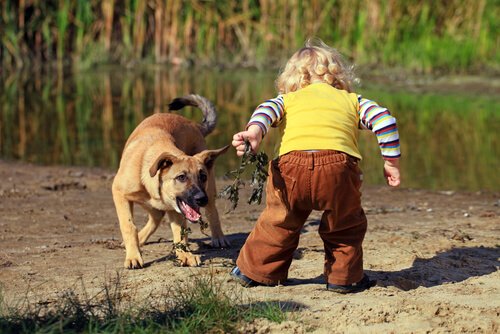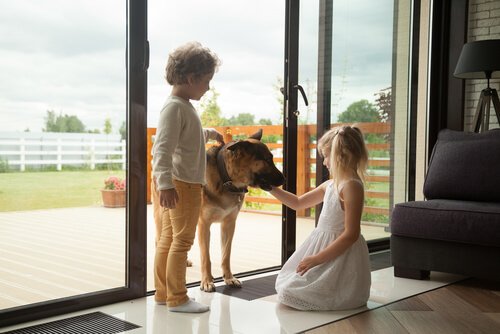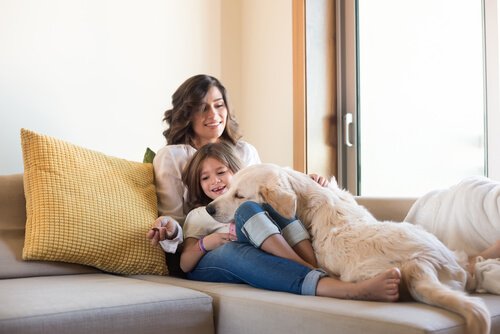How Children Should Interact With Dogs

If we look at the statistics of dog bites, the number of children that are injured in comparison to adults is alarming. The vast majority of attacks are with children. Virtually all of these incidents are preventable, so we’ll give you some guidelines on what a child’s interaction with dogs should be like.
The statistics of attacks
The figures are clear: the majority of dog bites happen to minors. And the experts are also clear on something else: these situations occur because children don’t know how to treat dogs with respect.
Therefore, it’s very important that parents get the facts on how children should interact with dogs. If a child knows the basic rules of respect and safety when they’re around a dog, the dog won’t feel uncomfortable and defensive. These basic rules will teach the child that he has to respect the dog so he won’t scare him.

How children should interact with dogs: basic rules for safe interaction
You can see why it’s so important to establish basic rules for how your child will interact with dogs. These rules should apply to unknown, strange dogs, but also to the family dog.
1. Don’t disturb a dog who is sleeping or eating
We humans get annoyed when someone wakes us up, don’t we? Likewise, no one should ever wake a sleeping dog — and this goes for both children and adults. A dog in a bad mood may bite.
Although your dog may not usually have problems with their food, they may become violent if you bother them while they’re eating, take their food away, or put your hand near their bowl.
2. Don’t pull on a dog’s ear, tail or whiskers
Children may think it’s a game to explore a dog’s body, but the dog doesn’t see it that way. So, you should teach your child that he can’t always satisfy his curiosity. He shouldn’t pull on the dog’s tail or look inside of the dog’s ears; this may bother or even hurt a dog.
3. If a dog wants to go, let them go
This is another norm that adults should point out to children: when a dog wants to leave, you have to respect that. A dog can get overwhelmed when there’s a lot of people at home, when they’re getting too much attention, when there are strangers in the house or when there’s a lot of noise.

No matter the reason, if the dog wants to leave or go lay down, let them go. This is especially true if you’re touching or petting them. If you hold a dog against their will, they may get anxious and act without thinking.
4. Don’t go near a dog’s rest area
Related to the previous point, it’ll be helpful to create a rest area for your dog where they can sleep without interruptions. By “rest area,” we mean the dog bed and the space around it, and that will depend on the size of your house.
You shouldn’t enter this area or bother your dog when they’re in it: it’s their safe place. Kids should never lie on the dog bed or interrupt them while they’re sleeping. The dog should consider it a place to escape to when necessary.
5. Don’t tease a dog
This rule is clear: making a dog feel bad isn’t a game. You shouldn’t take their toys away, and you shouldn’t promise them food and then withhold it. Don’t take anything from a dog’s mouth. And don’t give them a lot of commands without a treat in return.
It may seem like a game to children, but for the dog it’s a reason to attack. Although they may seem to have more patience with children, they may get overwhelmed or over-excited — and react poorly.
6. A child should never punish, hit or discipline a dog
Since punishments aren’t an effective tool in dog training, a child should never punish a dog in any way. Adults should be the ones in charge of training, not children.

To be very clear, hitting the dog should be completely prohibited. Even if a child is playing, or thinks he’s doing it gently, the dog may take it badly and hurt the child.
Supervision and example
In any case, children should be supervised when they’re around dogs. Children, especially young ones, still don’t know how to control their strength or their bodies well. That is why it’s important that an adult always be present.
Of course, the best example for a child of how to treat a dog correctly will come from the adults around them. If you want your children to interact with dogs safely, you should show them how to properly do it: treat your pet with respect and teach your kids to pet them gently and not disturb them.
These precautions should be taken into account even if your family dog has always tolerated children well. Dogs have bad days too, and they may get upset and react instinctively. If a dog bites a child, it’s the responsibility of the adult who didn’t prevent the situation.
If we look at the statistics of dog bites, the number of children that are injured in comparison to adults is alarming. The vast majority of attacks are with children. Virtually all of these incidents are preventable, so we’ll give you some guidelines on what a child’s interaction with dogs should be like.
The statistics of attacks
The figures are clear: the majority of dog bites happen to minors. And the experts are also clear on something else: these situations occur because children don’t know how to treat dogs with respect.
Therefore, it’s very important that parents get the facts on how children should interact with dogs. If a child knows the basic rules of respect and safety when they’re around a dog, the dog won’t feel uncomfortable and defensive. These basic rules will teach the child that he has to respect the dog so he won’t scare him.

How children should interact with dogs: basic rules for safe interaction
You can see why it’s so important to establish basic rules for how your child will interact with dogs. These rules should apply to unknown, strange dogs, but also to the family dog.
1. Don’t disturb a dog who is sleeping or eating
We humans get annoyed when someone wakes us up, don’t we? Likewise, no one should ever wake a sleeping dog — and this goes for both children and adults. A dog in a bad mood may bite.
Although your dog may not usually have problems with their food, they may become violent if you bother them while they’re eating, take their food away, or put your hand near their bowl.
2. Don’t pull on a dog’s ear, tail or whiskers
Children may think it’s a game to explore a dog’s body, but the dog doesn’t see it that way. So, you should teach your child that he can’t always satisfy his curiosity. He shouldn’t pull on the dog’s tail or look inside of the dog’s ears; this may bother or even hurt a dog.
3. If a dog wants to go, let them go
This is another norm that adults should point out to children: when a dog wants to leave, you have to respect that. A dog can get overwhelmed when there’s a lot of people at home, when they’re getting too much attention, when there are strangers in the house or when there’s a lot of noise.

No matter the reason, if the dog wants to leave or go lay down, let them go. This is especially true if you’re touching or petting them. If you hold a dog against their will, they may get anxious and act without thinking.
4. Don’t go near a dog’s rest area
Related to the previous point, it’ll be helpful to create a rest area for your dog where they can sleep without interruptions. By “rest area,” we mean the dog bed and the space around it, and that will depend on the size of your house.
You shouldn’t enter this area or bother your dog when they’re in it: it’s their safe place. Kids should never lie on the dog bed or interrupt them while they’re sleeping. The dog should consider it a place to escape to when necessary.
5. Don’t tease a dog
This rule is clear: making a dog feel bad isn’t a game. You shouldn’t take their toys away, and you shouldn’t promise them food and then withhold it. Don’t take anything from a dog’s mouth. And don’t give them a lot of commands without a treat in return.
It may seem like a game to children, but for the dog it’s a reason to attack. Although they may seem to have more patience with children, they may get overwhelmed or over-excited — and react poorly.
6. A child should never punish, hit or discipline a dog
Since punishments aren’t an effective tool in dog training, a child should never punish a dog in any way. Adults should be the ones in charge of training, not children.

To be very clear, hitting the dog should be completely prohibited. Even if a child is playing, or thinks he’s doing it gently, the dog may take it badly and hurt the child.
Supervision and example
In any case, children should be supervised when they’re around dogs. Children, especially young ones, still don’t know how to control their strength or their bodies well. That is why it’s important that an adult always be present.
Of course, the best example for a child of how to treat a dog correctly will come from the adults around them. If you want your children to interact with dogs safely, you should show them how to properly do it: treat your pet with respect and teach your kids to pet them gently and not disturb them.
These precautions should be taken into account even if your family dog has always tolerated children well. Dogs have bad days too, and they may get upset and react instinctively. If a dog bites a child, it’s the responsibility of the adult who didn’t prevent the situation.
This text is provided for informational purposes only and does not replace consultation with a professional. If in doubt, consult your specialist.







